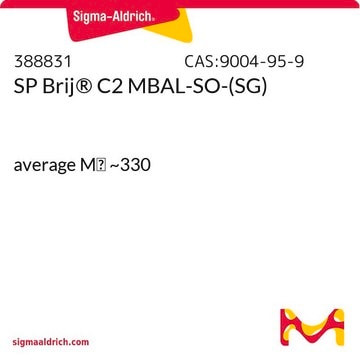16006
SP Brij® S2 MBAL
main component: diethylene glycol octadecyl ether
Sinónimos:
Brij® S2, Polyethylene glycol octadecyl ether, Polyoxyethylene (2) stearyl ether
About This Item
Productos recomendados
descripción
non-ionic
mol peso
358.60 g/mol
técnicas
protein quantification: suitable
mp
44-45 °C (lit.)
valor de HLB
4.9
densidad
0.893 g/mL at 25 °C (lit.)
aplicaciones
microbiology
cadena SMILES
O(CC[O])CCCCCCCCCCCCCCCCCC
InChI
1S/C20H41O2/c1-2-3-4-5-6-7-8-9-10-11-12-13-14-15-16-17-19-22-20-18-21/h2-20H2,1H3
Clave InChI
PSEGVHKUPXNGGJ-UHFFFAOYSA-N
¿Está buscando productos similares? Visita Guía de comparación de productos
Información legal
Palabra de señalización
Warning
Frases de peligro
Consejos de prudencia
Clasificaciones de peligro
Acute Tox. 4 Oral
Código de clase de almacenamiento
11 - Combustible Solids
Clase de riesgo para el agua (WGK)
WGK 2
Punto de inflamabilidad (°F)
Not applicable
Punto de inflamabilidad (°C)
Not applicable
Equipo de protección personal
Eyeshields, Gloves, type N95 (US)
Elija entre una de las versiones más recientes:
¿Ya tiene este producto?
Encuentre la documentación para los productos que ha comprado recientemente en la Biblioteca de documentos.
Los clientes también vieron
Nuestro equipo de científicos tiene experiencia en todas las áreas de investigación: Ciencias de la vida, Ciencia de los materiales, Síntesis química, Cromatografía, Analítica y muchas otras.
Póngase en contacto con el Servicio técnico






